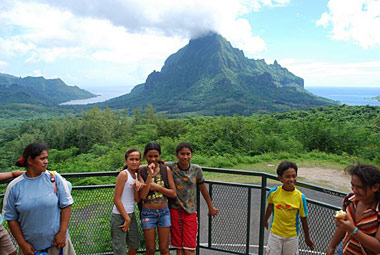| Brad Balukjian teaches a 5th grade class from the École Primaire de Paopao on the island of Moorea in French Polynesia. |  |
Growing young scientists in Tahiti
| 06 July 2009
BERKELEY — A University of California, Berkeley, project to catalog nearly every living thing on the Polynesian island of Moorea is enlisting the help of the island's 5th graders and showing them that science is not for foreigners only.
While conducting research for his thesis and for the Moorea Biocode Project, UC Berkeley graduate student Brad Balukjian has been teaching 5th graders at the Paopao Primary School about biodiversity and introducing them to the scientific study of the plants and animals they see every day.
 Balukjian's Tahitian students amid the natural splendor of their South Pacific island home. (Brad Balukjian photos)
Balukjian's Tahitian students amid the natural splendor of their South Pacific island home. (Brad Balukjian photos)At an end-of-year science fair on June 25, Balukjian's students proudly presented their collections of Moorean insects and plants to parents and fellow students. Each student had also collected a specimen specifically for the Moorea Biocode Project database, so that its DNA profile could be entered along with the student collector's name.
"They are immortalized in the biocode database," Balukjian said.
Balukjian, who had to polish his high school French to conduct two weekly science classes to kids whose native tongue is Tahitian, noticed a distinct change in his students' attitude toward science during the school year. Previously, the youngsters had little background in the subject.
At the beginning, they questioned whether "there is such a thing as a Tahitian scientist," Balukjian said. "I designed the class to change their perception that science is something that adults and foreigners do. At the end, they were saying that it's fun to be a scientist."
 Students explain their insect and plant collections at the end-of-year Exposition des Sciences in June.
Students explain their insect and plant collections at the end-of-year Exposition des Sciences in June.In Moorea at the June 25 "Exposition des Sciences," both the Tahitian Minister of Culture and Education Jean-Marius Raapoto and the vice-mayor of Moorea, Alexandre Hanere, showed up to listen to the students explain their projects, Balukjian said.
"The kids really enjoyed showing off what they had done," he said.
All the projects dealt with the biodiversity of the island, with which Tahitian kids already are familiar because they have grown up playing outdoors, unlike many kids in the United States, Balukjian said.
"There's something extra special about teaching biodiversity in an island context, because there are a lot of plants and animals that are unique to an island, they are endemic," said Balukjian, who admits to a bias toward islands dating from his childhood in Rhode Island, when he convinced fishermen to drop him off on one of the state's many islands to explore the animal life. "It was great to be able to say that we are going to focus on the biodiversity of your island, here in Moorea."
 Fifth graders from the École Primaire de Paopao on an outing to collect insects.
Fifth graders from the École Primaire de Paopao on an outing to collect insects."Maybe they are generalists and can eat new introduced plants while other insects can't," he said. DNA collected from the insects may reveal answers as well as the million-year history of these insects, many of which are found throughout the Polynesian Islands.
All his data, plus that of the 5th grade students, will be entered into the biocode database, which is being compiled by scientists at UC Berkeley's Richard B. Gump South Pacific Research Station, where Balukjian works, and France's CNRS-EPHE Centre de Recherches Insulaires et Observatoire de l'Environnement (CRIOBE).
Balukjian's teaching stint fits with the spirit of that project, and with the teaching experience required of all UC Berkeley graduate students.
"There is no doubt that my on-the-ground training in communication was enormous," Balukjian said, given that he had to invent the curriculum in collaboration with the Moorean school. "When I go back to the States and give a presentation, it will be like a walk in the park by comparison. It was truly valuable to have that challenge."

